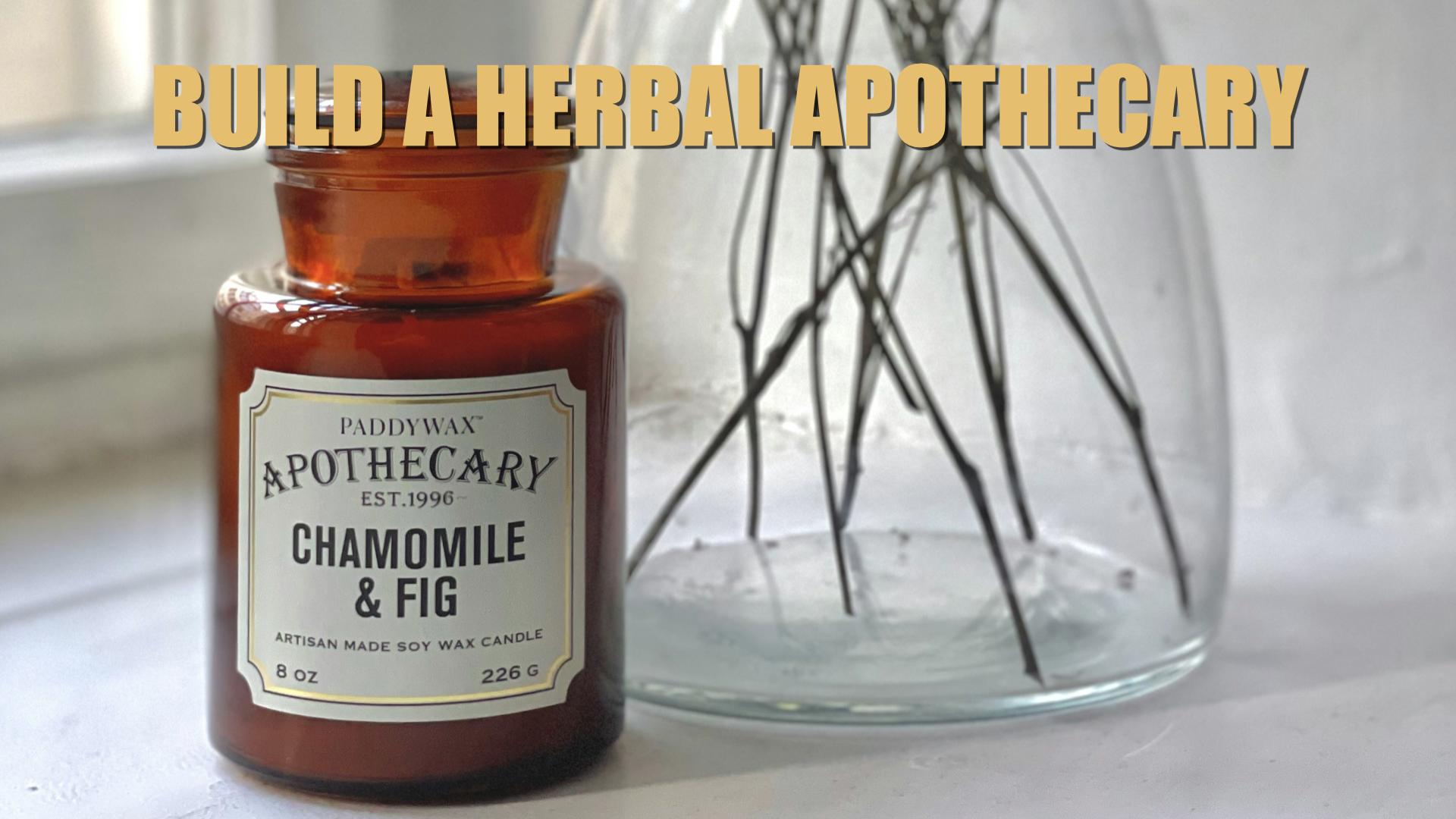Creating your own herbal apothecary is an exciting step on your journey into herbalism. Whether you’re interested in natural remedies for everyday wellness, first aid, skincare, or spiritual practice, having a well-organized collection of herbs and supplies will help you build confidence and consistency in your practice. This guide walks you through the essentials, with a strong focus on must-have herbs and best practices for storage, labeling, and organization.
First, Consider Your Herbal Needs
Before assembling your herbal apothecary, pick up a plant identification book or two (you’ll find recommendations in our Master Reading List).
Next, take a moment to consider the purpose of your herbal apothecary. What do you want to use your herbs for? Some common focuses include:
- General Wellness – Herbal teas and tonics to support digestion, sleep, and immunity.
- First Aid – Herbs for cuts, burns, insect bites, and common ailments.
- Stress & Emotional Support – Calming and adaptogenic herbs to balance the nervous system.
- Skincare & Beauty – Herbs for homemade salves, oils, and skin tonics.
- Spiritual & Energetic Work – Herbs for incense, baths, and meditation rituals.
By defining your goals, you can start with herbs that align with your needs rather than feeling overwhelmed by endless choices.
Not All Herbs Grow Everywhere: Choosing Local Plants
While it may be tempting to seek out exotic herbs from around the world, it is often more practical and sustainable to focus on herbs that grow naturally in your region. Not all plants thrive in every climate, and sourcing locally available herbs can offer several benefits:
- Sustainability – Using native or locally grown plants reduces environmental impact and supports biodiversity.
- Accessibility – Local herbs are often easier to find, whether through wildcrafting, gardening, or purchasing from local herbalists.
- Tradition and Effectiveness – Plants that have been used historically in your region may be particularly well-suited to the local environment and health needs.
Research the medicinal plants that grow near you and consider integrating them into your apothecary. Many common herbs such as chamomile, peppermint, and calendula are widely available, but you may also discover lesser-known local plants with valuable properties.
Sourcing Quality Herbs
The effectiveness of your herbal remedies depends greatly on the quality of the herbs you use. Here’s how to ensure you’re getting the best:
- Buy from Reputable Suppliers – Choose organic, ethically sourced herbs from trusted herbal shops or suppliers.
- Grow Your Own Herbs – If possible, cultivate your own medicinal herbs to ensure freshness and sustainability.
- Harvest Ethically – If wildcrafting, only take what you need, avoid endangered plants, and harvest responsibly to ensure plant populations remain healthy.
- Check for Freshness – Dried herbs should retain their color and aroma; avoid herbs that are pale, brown, or have lost their scent.
- Avoid Contaminated Sources – Be cautious of herbs from areas exposed to pesticides, pollution, or heavy metals.
Must-Have Herbs for a Starter Herbal Kit
For beginners, it’s best to start with a manageable selection of versatile herbs that have a wide range of uses. Here are some essentials to include in your first apothecary:
1. Chamomile (Matricaria chamomilla)
- Uses: Calming, digestive aid, anti-inflammatory, great for teas and skin care.
- Forms: Dried flowers, tincture, infused oil.
2. Peppermint (Mentha × piperita)
- Uses: Supports digestion, relieves headaches, decongestant.
- Forms: Dried leaves, tincture, essential oil.
3. Lavender (Lavandula angustifolia)
- Uses: Relaxation, sleep support, wound healing, skin care.
- Forms: Dried flowers, essential oil, infused oil.
4. Calendula (Calendula officinalis)
- Uses: Skin healing, anti-inflammatory, antiseptic.
- Forms: Dried petals, infused oil, salve.
5. Echinacea (Echinacea purpurea)
- Uses: Immune support, cold and flu prevention.
- Forms: Dried root, tincture, capsules.
6. Ginger (Zingiber officinale)
- Uses: Digestion, nausea, circulation, warming for colds.
- Forms: Fresh root, dried slices, powder, tincture.
7. Yarrow (Achillea millefolium)
- Uses: Wound healing, fever reducer, menstrual support.
- Forms: Dried flowers and leaves, tincture, infused oil.
8. Lemon Balm (Melissa officinalis)
- Uses: Stress relief, antiviral properties, digestive support.
- Forms: Dried leaves, tincture, infused honey.
9. Plantain (Plantago major)
- Uses: Wound healing, insect bites, skin irritation.
- Forms: Fresh leaves, dried leaves, infused oil, salve.
10. Nettle (Urtica dioica)
- Uses: Nutrient-rich tonic, anti-allergy, anti-inflammatory.
- Forms: Dried leaves, tea, tincture, infused vinegar.
These foundational herbs will provide a solid base for a variety of remedies and can be expanded upon as you gain experience.
Storage, Labeling, and Organizing Your Herbal Supplies
Proper storage is crucial to maintaining the potency and longevity of your herbs. Follow these best practices to keep your apothecary fresh and well-organized.
Storage Tips:
- Choose Airtight Containers – Glass jars with tight-fitting lids (such as mason jars) protect herbs from moisture and air.
- Keep Away from Light & Heat – Store herbs in a cool, dark place, like a cupboard or pantry, to prevent degradation.
- Use Small Containers for Frequent Use – Keep small jars or tins for easy access while storing bulk herbs separately.
- Label Everything Clearly – Avoid confusion by labeling each jar with:
- Herb name (common & botanical)
- Date of harvest or purchase
- Part used (leaf, flower, root, etc.)
- Storage instructions (if specific, such as refrigeration for fresh herbs)
Organizing Your Herbal Apothecary:
- Sort by Type – Arrange herbs by category: digestive, immune, skincare, etc.
- Use Baskets, Drawers, or Shelves – Keep herbs neatly arranged in a dedicated space.
- Create an Herbal Inventory List – Track what you have, when to restock, and expiration dates.
- Store Infused Oils & Tinctures Separately – Keep liquids in dark glass bottles and label with preparation date.
- Include Essential Tools – Have a mortar and pestle, measuring spoons, strainers, and dropper bottles on hand for easy preparation.
Safety Considerations & Contraindications
Before using any herb, it’s important to be aware of potential safety concerns. Not all herbs are suitable for everyone, and some can interact with medications or specific health conditions. Here are key safety tips:
- Know Possible Interactions – Some herbs can affect prescription medications, such as St. John’s Wort interfering with antidepressants.
- Check for Allergies – If you have pollen allergies, test small amounts of new herbs before use.
- Use Caution During Pregnancy & Nursing – Some herbs, like pennyroyal and black cohosh, can be unsafe during pregnancy.
- Start with Small Doses – When trying a new herb, begin with a low dose and observe how your body reacts.
- Consult an Herbalist or Healthcare Provider – If you have existing health conditions, seek professional advice before using medicinal herbs.
Expanding Your Apothecary Over Time
Once you have the basics, you can gradually expand your herbal collection based on your interests. You may want to:
- Grow Your Own Herbs – Start a small medicinal garden for fresh supply.
- Explore Herbal Fermentations – Try making herbal vinegars, oxymels, and meads.
- Learn More About Advanced Preparations – Experiment with syrups, electuaries, and herbal capsules.
- Incorporate More Wild Herbs – Forage for local medicinal plants with proper identification.
Building your first herbal apothecary is a rewarding and empowering experience. By carefully selecting essential herbs, storing them properly, and organizing your supplies, you’ll create a personal herbal toolkit that supports your health and well-being. Start small, keep learning, and enjoy the journey of herbal discovery!



